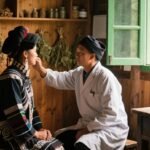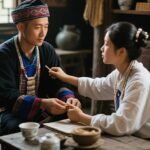Medical Story from Late Qing Beijing
Cultural Context: This story reflects traditional Chinese medical practices in 19th century Beijing. At the time, TCM (Traditional Chinese Medicine) was mainstream, and the Old Summer Palace (Yuanmingyuan) was an imperial complex where officials worked.
Summer of Yimao Year (approx. 1915 by Gregorian calendar), I was residing in Beijing. One morning while dressed in official robes to report duty at the Old Summer Palace (Note: This imperial garden was later destroyed by Anglo-French forces in 1860), an elderly woman suddenly knelt before my carriage.
She pleaded tearfully: “My grandson has severe smallpox (Note: A deadly infectious disease eradicated worldwide in 1980). We heard Your Excellency has medical skills. Please save him!” I explained urgently: “I’m not a professional physician and have no expertise in treating infectious diseases. You should consult specialists.”
But the woman kept kowtowing (Note: Traditional Chinese act of extreme supplication involving forehead-to-ground bows), her brow bleeding. Neighbors gathered to implore me, so I reluctantly followed her. Her home turned out to be adjacent to mine – their maid had been watching the street daily, as my gatekeeper had informed them about me (Note: Wealthy households employed gatekeepers to screen visitors).
The 4-5-year-old boy exhibited alarming symptoms: dark purple non-raised rashes, cold extremities, and persistent diarrhea. Yet his rashes were evenly distributed, and he could still eat 2-3 bowls of congee daily. I diagnosed: “Insufficient vital energy (Note: ‘Qi’ in TCM theory) to fight the pathogen, worsened by excessive cold-natured herbs (TCM classifies herbs as ‘hot’ or ‘cold’ properties).”
Reviewing his 10-day medical record confirmed previous prescriptions used mainly Huangqin (baical skullcap) and Huanglian (coptis root) – herbs TCM considers “cold.” I prescribed Liuwei Huiyang Yin (Literal: Six-Ingredient Yang-Returning Decoction):
Processed aconite root (Note: Contains toxic alkaloids, modern use requires professional supervision)
Dried ginger
Licorice root
Chinese angelica (Danggui)
Codonopsis root (Dangshen)
Cinnamon bark
Zao Xin Tu (clay from furnace hearths; TCM believes it stops bleeding/diarrhea)
When asked about dosage, I advised at least three consecutive days. Rushing to duty, I later forgot this incident amidst official duties.
Days later during rainy weather, the grandmother brought her recovered grandson to thank me. I finally recalled the case and cautioned: “Post-smallpox recovery requires strict wind avoidance (TCM believes ‘wind’ carries pathogens into weakened bodies).” With this advice, I returned home.
Modern Disclaimers:
Smallpox was eradicated in 1980 through global vaccination efforts
Aconite in Liuwei Huiyang Yin is toxic – NEVER use historical formulas without licensed TCM practitioners
TCM concepts like “Qi” and “wind pathogens” differ fundamentally from modern medicine
Always consult healthcare professionals for infectious diseases



Leave a Reply